Which cable to use for wiring in a wooden house: types of non-flammable cable and its safe installation
Comfort in the home is inextricably linked to electricity. Therefore, uninterrupted and safe operation of the electrical network is very important.Since buildings made of timber or logs are the most complex objects in this regard, you must definitely figure out which cable to use for wiring in a wooden house in order to ensure the safety of your home.
We will tell you how to choose a cable in order to fully protect a building that is easily flammable. We'll show you how to eliminate risky situations associated with improperly installed wiring. The article we have proposed describes the brands of products acceptable for installation, and provides recommendations on the choice of cable cross-section.
The content of the article:
Design features of non-flammable cable
First of all, the electrical distribution in a wooden building must meet the requirements of the PUE. For this purpose, non-flammable cables are used and laid in special systems. Non-flammable cables, if you focus on GOST 31565-2012, have several types of execution.
Let's consider all types of non-combustible cable structure:
- Products that do not spread combustion in case of single wiring.
- Cables ng - in which combustion does not spread with a group wiring method.
- Type ng-LS - the same, but also with low gas and smoke emissions.
- ng-HF cables - the same, and not emitting gaseous corrosive substances during combustion and smoldering during group wiring.
- Type ng-FRLS - fire-resistant, unable to propagate combustion using the group installation method with low gas and smoke emission.
- ng-FRHF cables — not emitting gaseous corrosive substances during group wiring during combustion and smoldering.
- Type ng-LSLTx - non-flammable during group wiring with low gas and smoke emissions, with combustion products of low toxicity.
- ng-HFLTx cables - non-flammable in the group wiring method, not emitting gaseous corrosive substances during combustion and smoldering, with combustion products of low toxicity.
- Type ng-FRLSLTx - non-flammable during group wiring with low gas and smoke emissions, with combustion products of low toxicity.
- Cables ng-FRHFLTx - non-flammable wiring using the bundle method, which does not emit gaseous corrosive substances during combustion and smoldering, with combustion products of low toxicity.
It should be noted that the frequently used expression “non-flammable cables” sounds incorrect. It often means fire-resistant products that do not transmit combustion, cables with flame-retardant sheaths.
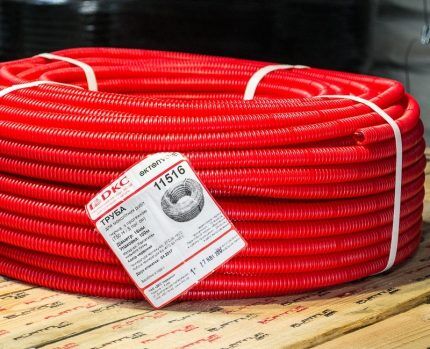
Cables that do not spread fire in any type of installation immediately stop working when exposed to fire, because... the insulation and sheathing burns or melts. If a fire starts, in any case type of cables and wires The fire must not spread.
Fire-resistant products for wiring devices retain the ability to function in the event of a fire for a certain time.This is the main difference between these two types of cable products.
Explanation of cable markings
All types of non-flammable cables produced by domestic manufacturers have the letter combination “ng” in their designation. It indicates that the product is a flame retardant cable product.
The marking also contains the following symbols that characterize their behavior during combustion:
- L.S. - low gas and smoke emission.
- LSLTx — low gas and smoke emission, low toxicity of emissions.
- HF — both during combustion and smoldering there are no corrosive gas emissions. Such products do not contain halogen additives - bromine, fluorine, chlorine and other non-metals.
To execute wiring on wooden surfaces In a private house, according to its parameters, a cable marked only with the letter combination “ng” is suitable. If it is necessary to ensure the maximum safety of people in case of evacuation, it is better to take more expensive products - “LS”, “LSLTx”, “HF”.
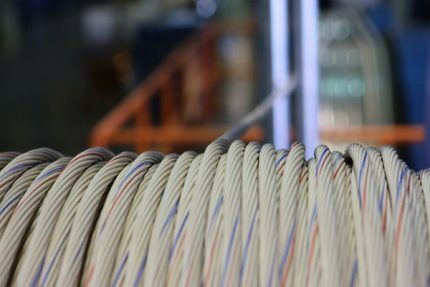
The VVGng cable is resistant to high temperatures, because PVC plastic without halogen additives is used in its production. This type is characterized by an ideal price-quality ratio. They are laid in places where there is a fairly high risk of explosion. Systems using these cables operate for over 180 minutes.
Details about the VVGng cable and its LS type
Using this external cable, they provide power to stationary and mobile electrical appliances.Both VVGng and LS can perform their assigned tasks in a wide variety of conditions.
The main properties of the latter are:
- Moisture resistance. Ability to function in rooms with high humidity.
- Possibility of high-rise installation. With its help, you can install electrical wiring underground, in a mine.
- Fire resistance. It not only does not promote combustion, but also does not smoke under the influence of fire.
- High technical characteristics, making it possible to use VVGNG LS in the oil and chemical industries.
The technical parameters of the products in this series are different. In accordance with the standards, the value of the permissible current voltage is 0.6 V. In practice, there are cables with higher values of this parameter. Current frequency - maximum 50 Hz.
These products are flexible and have such strong insulation that it is almost impossible to damage it. The service life of cables belonging to this series is up to 30 years.
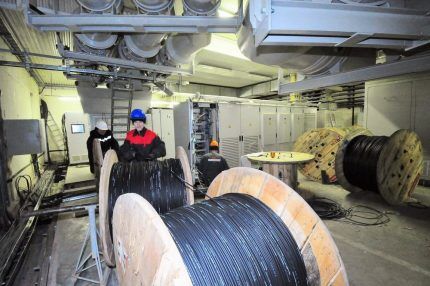
All VVGng cables, including LS, are power cables. They are made from copper. The maximum number of cores is five. For the home, two-core products are most often used. The minimum cross-section of the core of all products of the VVG series is 1.5 mm².
The most popular color for outer insulating sheathing is black, but it is quite common to find white insulation.
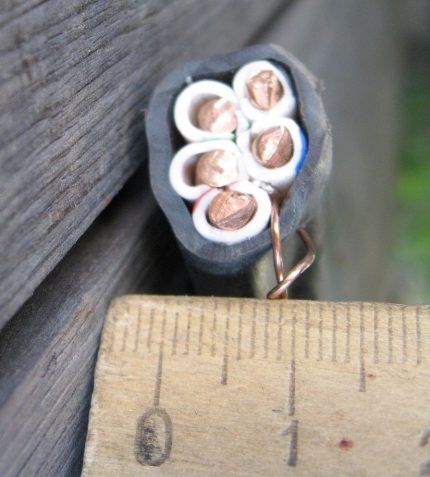
The symbols in the VVGng designation mean:
- IN — shell material is vinyl;
- G — the cable has a “bare” core with protection in the form of double PVC insulation;
- ng - non-flammable.
Since there is no “A” symbol in the marking, the cable is made of copper. LS, but completely low smoke indicates the product's inability to burn. The price of one meter of cable is related to the number of cores and their cross-section. In the case of three-phase voltage, a stranded conductor is used.
The design of VVGNG LS includes single-wire or multi-wire conductors. The geometry of the veins can be either in the form of a circle or a sector. It is not recommended to install it underground without special protection. To prevent the cable from spreading fire, it is used for batch wiring in special bundles.
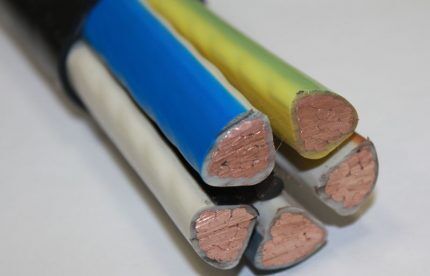
VVGNG LS is used at temperatures of 30 - 50 °C, and its characteristics remain unchanged even when the cores are heated to +400 °C.
If the integrity of the cable is not compromised and it contains single-wire conductors, it can be bent under a mounting radius identical to ten outer diameters. If there are stranded conductors, the maximum radius is 7.5 outer diameters.
Familiarize yourself with the rules and formulas used in calculating cable cross-sections next article, which we strongly recommend reading.
Tips for safe styling
Both the choice of materials, the method of laying wiring, and the method of installing installation products in a wooden house have their own specifics. The priority issue is safety.
What standards must the wiring comply with?
If the base is flammable, installation must be carried out using an open method or the conductor must be localized by enclosing it in a protective sheath.
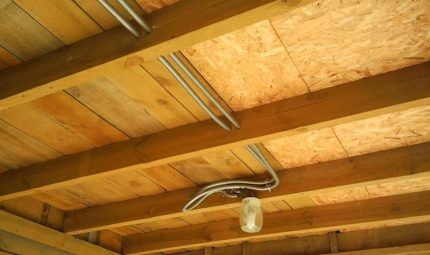
An important point is to ensure good access to the cable when placing it in a protective casing.
Even if the wiring in a wooden house is carried out by experienced electricians, in order to evaluate their work, you need to know three basic rules for it:
- Prevent even the possibility of fire of electrical cables or at least reduce it to a minimum. In any case, they must not transmit open fire to wooden elements in the event of a short circuit. (short circuit) in the electrical circuit. Therefore, the wires should not come into contact with the wooden surface.
- The cable parameters must be 100% compliant with the PUE and have a power reserve to easily withstand maximum loads. Any degree of heating of the terminal connections and input cable is unacceptable.
- Electrical wires must be in perfect technical condition to eliminate the slightest chance of electric shock to the inhabitants of the house.
Safety rules cannot be pushed into the background for the sake of the aesthetic component. The consequences may be irreversible. All wiring branches in a wooden house must be equipped with automatic switches and other protective shutdown devices.
Subtleties of cable entry into a wooden house
There are two key ways to enter a non-flammable cable for its further wiring in a wooden house while maintaining safety. First - underground laying. The method is reliable because the cable is protected from external influences.
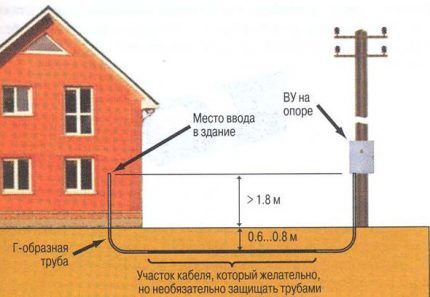
Second method - over-the-air wiring. A permit is required here, and without it you cannot work on electric poles. Therefore, the work can only be carried out by suitably qualified electricians.
The diameter of the cable on the section pole - house cannot be less than 16 mm. Here it is better to use self-supporting aluminum wires with good insulation and a service life of 25 years. It is impossible to continue the line with such a wire - a copper conductor is needed for the premises.
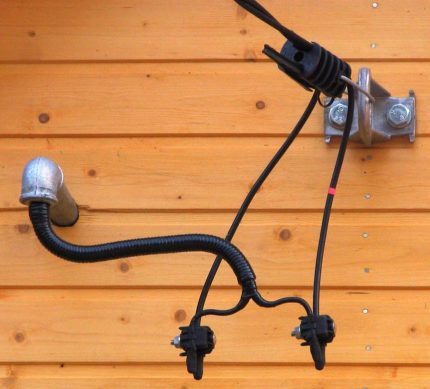
The actual insertion is carried out in a metal sleeve. To do this, make a hole in the wall, fix a pipe in it, and lay a cable inside it. The space that remains is filled with cement mortar. You can soak tow in the solution and use it as a pipe filler.
The cable is attached to the wooden wall using special clamps. They provide good non-oxidizing contact. If a cable is used to suspend the cable, an eye bolt is installed to secure it to the enclosing structure.
It is not permissible to install the cable under tension. It must hang freely along its entire length, and before inserting it into the wall, it must be positioned below the hole. Otherwise, atmospheric moisture will penetrate the cable into the house. You cannot overtighten the cable itself.
The rules also regulate the thickness of the pipe walls.A powerful cable requires protection up to 1 cm thick. When the cable cross-section does not exceed 4 mm, a sleeve with walls of 2.8 mm is sufficient. This rule is used for all wiring in the house.
Nuances of installation in the area up to the switchboard
This is also one of the important areas of electrical wiring. Its specificity lies in the fact that from overloads during a short circuit. it is not protected by automatic protection. The problem is solved by the following option: for a section up to 3 m long, the cable is placed entirely in a metal pipe.
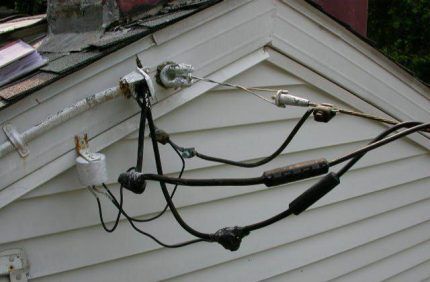
The RCD and a set of automatic devices are enclosed in a dust- and moisture-proof street boxing just before entering the wooden house. Triggering occurs when the load level exceeds the corresponding parameter of the main machine located in the switchgear.
When installing the meter, the main condition must be met - to avoid breaks in the supply line. Twisting is strictly unacceptable, so only a solid cable should be used for this.
Features of laying networks inside the house
Safe electrical wiring inside the house can be done in two ways: open and hidden. The first is simpler, but may not always match the style of the premises. But a hidden installation option, made in accordance with electrical safety requirements, will cost more.
Open Wiring Methods
There are several ways to install open wiring. All of them are safe; they are often chosen according to the design style. There are many on sale overhead electrical installation products for laying open wiring, there are installation techniques that can add some color to the interior.
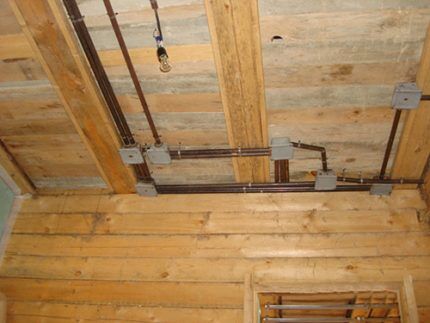
The cable is routed inside the building along the walls and ceiling. Wherein plastic cable ducts can be replaced corrugated polymer pipe or wire PV-1. The twisted cord is wound around ceramic insulators, which can be a highlight of the design. Such wiring can be modernized and new lines can be laid.
There is a wide range of self-extinguishing channels on the market. You can always match them to the color and style of the room.
Hidden wiring in a wooden house
Installing hidden electrical wiring in such a fire-hazardous building is a labor-intensive process. Choosing this option can create many problems if cable repairs or network upgrades are required. However, due to the reluctance to see exposed wires and junction boxes, many people prefer hidden installation.
Such wiring should be provided for at the design stage. To ensure maximum safety, the wiring is insulated using a metal or galvanized pipe, which must be coated with paint. The cable is connected to the socket and switch through openings that are pre-protected from fire.
Hidden installation method electricians in a wooden house are sold exclusively in accordance with regulations. Special materials are used that serve as fire protection.The cable laid in the ceilings must be in a plastic non-flammable pipe or in a metal sleeve.
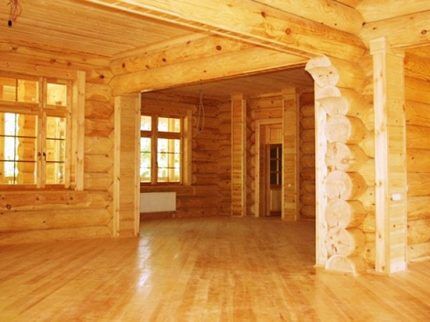
As practice shows, most often open and closed wiring methods are combined.
What do you need to know about cable cross-section?
This parameter is determined based on the current strength. If the cross-section and loads do not match each other, short circuits will occur, resulting in a fire. So, if the plans include closed wiring, and the estimated current is 16 A, a cable with a minimum cross-section of 2 mm² is required. With a rated current of 25 A - 4 mm².
Select cables according to distribution groups and depending on the expected load. In order to connect the sockets, you will need a cable with copper conductors with a cross-section of 2.5 mm². Maximum total power - 4.6 kW.
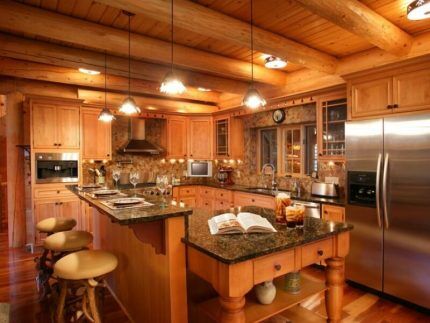
High-power home equipment is connected with a cable having a cross-section of 4 mm². Such devices must be connected to an individual outlet and cannot be connected to another group.
Conclusions and useful video on the topic
The main thing about electrical wiring in a fire-hazardous house:

The correct selection of cable for wiring in a wooden house is the key to the safety of its inhabitants. Due to the increased fire hazard of such a structure, it is necessary to use cable brands with a high degree of reliability.
One should not miss the point that cables and devices should not come into contact with wood. Provided that the wiring is wisely selected and carried out taking into account the recommendations, the efficiency, durability and safety of the wiring can be guaranteed.
Tell us about how you selected a cable to supply a country wooden house with electricity. Share interesting technological nuances that will be useful to site visitors. Please leave comments in the block below, ask questions, post photos on the topic of the article.




In a wooden house, it is worth paying increased attention to fire safety. And the wiring cable should also be chosen based on these considerations. Although it is not so easy to understand them, there are a lot of types of cables, each with its own marking. But do not forget that safety depends not only on the cable, but also on the correct installation of it. All kinds of “snot” should be avoided.
There is no point in running the cable to the house itself through the ground. Typically, this technique is used only in large farmsteads for drawing electricity between utility units. In addition to the digging work, you will have to buy a HDPE pipe for cable insulation. In this case, you will have to immediately calculate its length, even before purchasing, since if you make a mistake, even by securing individual pieces with a coupling, you will not be able to completely insulate the cable inside. In this case, it is better to take VVGz.
Good day, Sergey.
The impression is created that you did not understand the article.You have shaky arguments against trench laying: you can make a mistake when buying a pipe (measure carefully); used in large farmsteads (where are the statistics?); you will have to dig the ground (you will have to climb through the attic and install an external input). In parentheses, of course, are counterarguments.
Here are some more arguments based on the article - the author wrote one sentence about trench laying, noting the reliability of the solution. The author's air entry took almost twenty lines. I’ll add to the advantages of a trench: you can lay a backup cable in the pipe.
By the way, the fire safety class of VVGz is O1.8.2.5.4. What does this mean, look at the screenshot.
I would prefer to use NYM cable in my home, which, in addition to electrical insulation, also has a filling (between the core insulation and the sheath) with non-flammable filler. Something like chalk rubber. Its fire safety is higher; in addition, mechanical protection is better due to the filler. And another small plus - it is not black, but gray. When laying open, aesthetics must be paid attention to.
Good afternoon, Stepan.
Without detracting from the merits of NYM, I would like to note that the wire and cable products mentioned by the author of the article are no worse. By the way, chalk-containing rubber, which acts as a filler, improves the flexibility of the cable - it does not provide mechanical protection. About fire safety: during operation of NYM, heating of the cores is allowed up to +40º, for VVGng - up to +50º. In order not to describe the advantages of VVGng, I attached a screenshot of the comparison table.